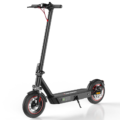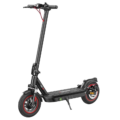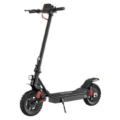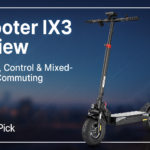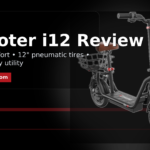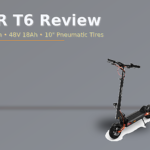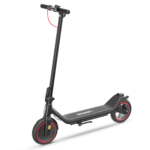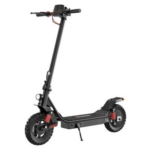- Home
- Scooters
- Electric Scooters
- iScooter iX5S
iScooter iX5S
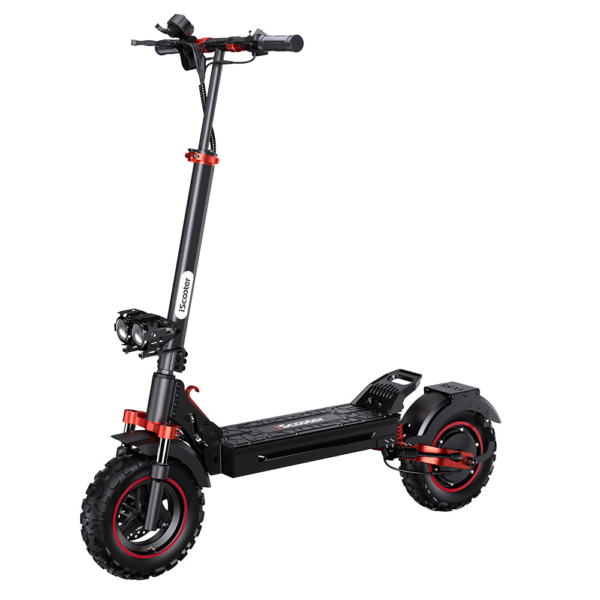

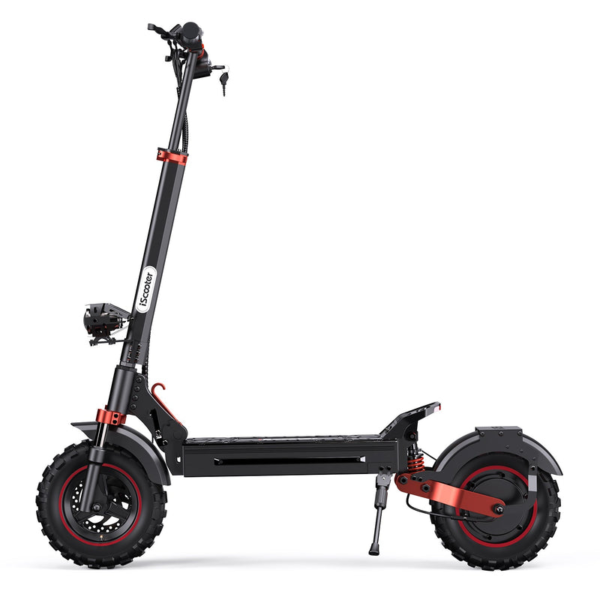
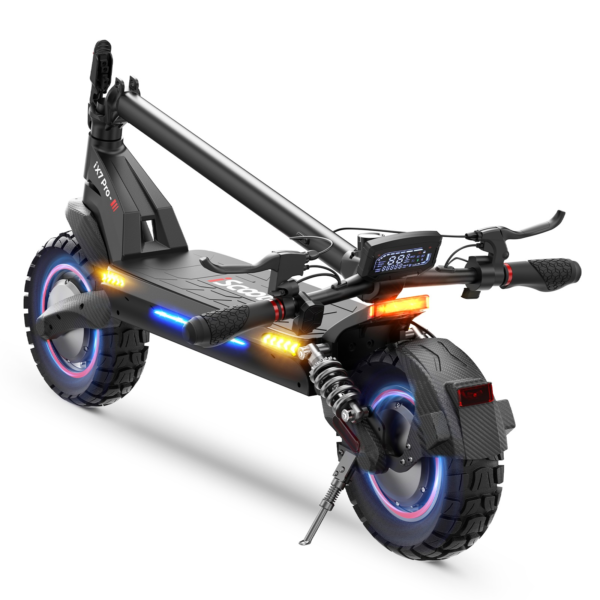
- Battery Range: 31–34 miles (50–55 km)
- Top Speed: 28 mph (45 km/h)
- Motor Power: 1000 W
- Weight Capacity: 330 lb (150 kg)
- Charging Time: ~5–7 h
- Scooter Weight: 60.0 lb (27.3 kg)
PROS
- 11″ off-road pneumatic tires
- Dual disc brakes + EABS
- IPX4 water resistance
- 48V 15Ah (720 Wh) battery; 5–7 h charge
- Full lighting incl. brake/turn/ambient
CONS
- Heavy for carrying (60 lb)
- App support not specified
- Folded dimensions not provided

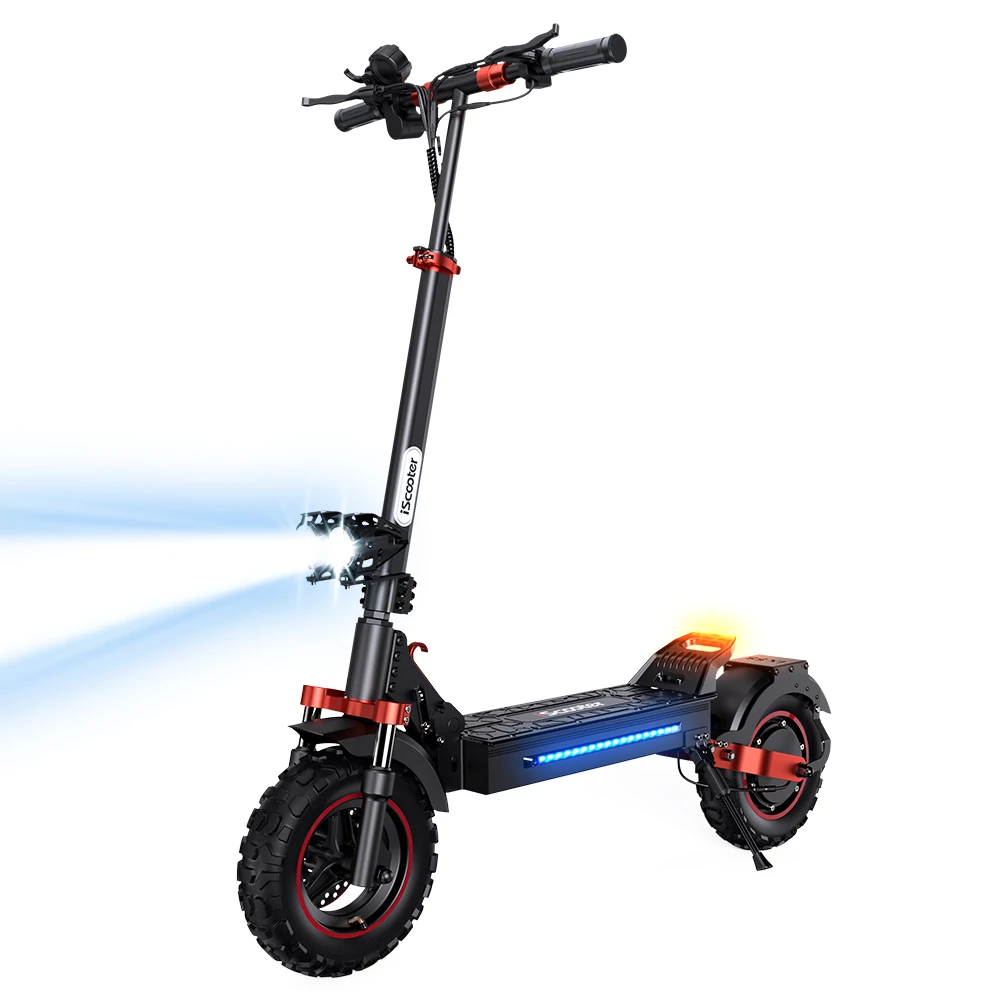

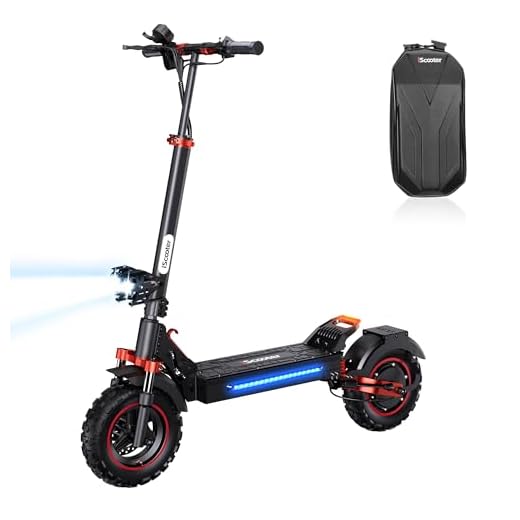
Table of contents
- What Is the iScooter iX5S?
- How the iScooter iX5S Works
- Key Specifications
- Design & Build Quality
- Performance Fundamentals
- Battery, Range & Efficiency
- Ride Quality & Comfort
- Braking & Safety Features
- Portability & Daily Usability
- Maintenance & Care
- Weather & Seasonal Considerations
- iScooter iX5S vs Alternatives
- Who the iScooter iX5S Is (and Isn’t) For
- FAQs
- Glossary
- Final Notes on Setup and Use
The iScooter iX5S is a folding, high-torque electric scooter designed for riders who want weekday dependability and weekend versatility. It pairs a 48V 15Ah battery with a 1000W rear hub motor, large 11-inch pneumatic tires, and dual suspension. As a result, it suits adults who value stability, usable power, and straightforward care more than ultra-light carry weight. If you’re cross-shopping within the lineup, the iScooter i10 Pro offers a lighter, commuter-leaning alternative while the iX5S focuses on comfort and rough-surface composure.
What Is the iScooter iX5S?
Simply put, the iScooter iX5S is a single-motor, rear-wheel-drive e-scooter with a reinforced frame and a long-range battery. Consequently, it occupies the “power commuter” slot: heavier and stronger than ultralight city models, yet easier to live with than big dual-motor machines. Because it rolls on 11-inch pneumatic tires and uses front-and-rear suspension, the ride stays composed on cracked asphalt, paving stones, and hard-pack trails. Nevertheless, it still folds into a compact footprint for hallway storage or trunk transport.
In practice, the iX5S balances everyday utility with light adventure. It accelerates confidently, tracks straight at cruise, and remains stable when pavement gets messy. Moreover, the controls are simple, so new riders adapt quickly without a learning curve.
How the iScooter iX5S Works
Electric scooters share familiar building blocks, and the iX5S follows that recipe with thoughtful tuning.
- Motor: A brushless hub motor sits inside the rear wheel. Because rear-drive places traction under your weight, it feels planted when you roll on the throttle. Additionally, the sealed design reduces routine maintenance.
- Controller: The controller acts as the scooter’s “brain.” It interprets throttle input and meters battery current to the motor. As a result, it shapes launch feel, hill behavior, and top-speed stability. Furthermore, it blends in electronic braking when you roll off or squeeze the levers.
- Battery: A 48-volt, 15-amp-hour lithium-ion pack stores energy (48V × 15Ah ≈ 720Wh). Generally, more watt-hours yield more range at similar speeds. Importantly, protective circuitry monitors voltage and temperature to safeguard the pack.
- Throttle: The throttle works like a dimmer switch. Hold a steady input and, in most modes, the controller maintains a constant speed. Conversely, releasing it tapers power smoothly.
- Brakes: The iX5S pairs front and rear disc brakes with electronic regen. Therefore, you get mechanical stopping power plus motor-based deceleration that enhances control and reduces pad wear.
Together, these systems produce a predictable, confidence-building ride: squeeze for firm, linear braking; roll on for smooth, progressive drive; and select a mode that matches traffic or terrain.
Key Specifications
The table below presents the official iScooter iX5S specifications in clear blocks, with both imperial and metric units for easy comparison.
General
| Item | Details |
|---|---|
| Model | iScooter iX5S |
| Intended use | Power commuter / light off-road |
| Water resistance | IPX4 (splash-resistant) |
| Max rider load | 330 lb (150 kg) |
| Riding modes | Two profiles with four levels each |
Performance & Power
| Item | Details |
|---|---|
| Motor | Rear hub, brushless, 1000W |
| Top speed (rated) | Up to 28 mph (45 km/h) |
| Climbing angle (rated) | Up to 25% grade (~14°) |
| Mode speeds (Comfort) | ~4 / 6 / 9 / 15 mph (6 / 10 / 15 / 25 km/h) |
| Mode speeds (Off-road) | ~9 / 15 / 22 / 28 mph (15 / 25 / 35 / 45 km/h) |
Battery, Charging & Electrical
| Item | Details |
|---|---|
| Battery | 48V 15Ah lithium-ion (~720Wh) |
| Max range (rated) | Up to ~40 mi (≈50–55 km), condition-dependent |
| Charger output | 54.6V, 2A |
| Charger input | AC 100–240V, 50/60 Hz |
| Charge time | ~5–7 hours |
| Display | LED multi-function |
| Lighting | LED headlight and rear light |
Build & Dimensions
| Item | Details |
|---|---|
| Frame material | A6061 aluminum alloy + steel |
| Tires | 11 in (279 mm) pneumatic off-road pattern |
| Suspension | Dual: front and rear |
| Unfolded size | 49.2 × 23.6 × 48.8 in (125 × 60 × 124 cm) |
| Folded dimensions | 50.8 × 9.5 × 18.1 in (129 × 24 × 46 cm) |
| Net weight | 60 lb (27.3 kg) |
Safety & Control
| Item | Details |
|---|---|
| Braking | Front & rear disc + electronic (regen assist) |
| Traction | Large pneumatic tires for grip and bump absorption |
| Visibility | High-mounted LED headlight; rear running light |
| IP rating | IPX4 (splash protection) |
Features & Extras
| Item | Details |
|---|---|
| Cruise Control | Yes, after holding a steady throttle for several seconds |
| Folding | Quick-fold stem; compact folded footprint |
| Height adjustment | Telescopic stem (height-adjustable) |
| Kickstand | Included |
| Mode profiles | Comfort and Off-road profiles with four levels each |
Warranty & Compliance
| Item | Details |
|---|---|
| Manufacturer warranty | 12-month limited warranty (coverage varies by region) |
| Regional compliance | Market-specific labeling and standards apply |
| Owner resources | Printed/online user manual for setup and care |
These specifications set clear expectations for performance, range, and daily use. Moreover, they frame how the scooter feels on real streets, not just on paper.
Design & Build Quality
From the first lift, the iX5S feels like a tool built for daily miles. Because the A6061 aluminum main frame is stout and key joints are reinforced, the chassis resists flex under braking and over rough patches. Meanwhile, the deck offers generous standing room, which encourages a stable, staggered stance. Since the 11-inch tires and dual suspension raise the ride height, the scooter gains extra bump clearance, which reduces deck strikes on sharp edges.
The stem locks with a solid clasp, and the telescopic section adapts to different rider heights. At the cockpit, the LED display shows speed, battery bars, and mode at a glance. Additionally, the throttle and levers sit within natural reach, so your hands settle quickly. Fit-and-finish trends functional rather than flashy: cables are routed cleanly, fasteners remain accessible, and the folding joint closes with a deliberate, confident action.
Because the scooter weighs about 60 lb (27.3 kg), it feels planted on choppy pavement. However, you will notice that mass when lifting. Even so, once rolling, the extra weight helps the frame shrug off chatter that would rattle lighter scooters. Finally, the deck rubber is grippy in the dry and easy to wipe down after wet rides.
Performance Fundamentals
Performance is more than a top-speed number; instead, it is how the iX5S behaves from launch to cruise and how it holds a line as surfaces change.
Acceleration feel: Under throttle, the rear-drive layout puts weight over the motor. Consequently, the iX5S steps off with traction rather than wheelspin. In low modes, it eases forward, which helps in pedestrian-heavy areas. In higher modes, it pulls briskly through urban speeds while remaining controllable.
Cruising stability: At 15–25 mph (25–40 km/h), the chassis feels calm. Thanks to the long wheelbase and 11-inch tires, steering inputs translate into smooth direction changes. Moreover, on wider bike lanes, it tracks straight without hunting or shimmy.
Hill-climb behavior: On typical 7–10% grades, the motor maintains practical speed, especially if you select a higher mode before the incline. Nevertheless, on long or very steep ramps, expect speed to taper, particularly for heavier riders. For steeper starts, a short running push and an athletic stance improve the first few feet.
Vibration and flex: Notably, the deck and stem resist flex during normal riding. Over repeated sharp bumps, you feel the suspension working rather than the frame bending, which is exactly what you want.
Battery, Range & Efficiency
The 48V 15Ah pack equals ~720Wh of stored energy. Consequently, in warm weather and moderate riding, the iX5S handles long commutes with range to spare. However, real-world distance depends on several variables:
- Rider weight: Heavier riders draw more current at the same speed, which reduces range.
- Speed and wind: Because air drag rises quickly with speed, cruising at 15–18 mph (24–29 km/h) stretches distance compared with flat-out riding.
- Terrain: Frequent stops, hills, and rough surfaces increase consumption.
- Temperature: Cold batteries deliver fewer amp-hours until they warm; extreme heat can trigger protective limits.
Given these factors, the rated range is a ceiling, not a promise. Even so, many riders see 25–35 miles (40–56 km) in mixed urban use at thoughtful speeds with proper tire pressure.
Charging best practices:
- After hard rides, let the scooter rest 15–30 minutes before charging; this stabilizes cell temperature.
- Use the 54.6V, 2A charger on a stable, ventilated surface.
- Avoid frequent deep discharges; finishing rides around 15–20% supports longevity.
- For off-season storage, keep the battery near 50–60% charge in a cool, dry place.
- Finally, reseat the charging-port cap firmly after unplugging.
With these habits, the pack maintains consistent performance across many cycles, and the specifications remain representative for longer.
Ride Quality & Comfort
Two components define the iX5S ride: pneumatic tires and dual suspension. Together, they filter harshness and preserve grip.
Tires: The 11-inch off-road pattern offers large air volume. Consequently, the tires smooth ripples and step over pothole edges with more confidence than smaller, solid alternatives. However, they require attention. Under-inflated tires feel draggy and heat up; over-inflated tires feel skittish and transmit sharp hits. Therefore, check pressures weekly and aim for a value that supports your weight without flattening the profile.
Suspension: The front and rear units are tuned for everyday bumps, not stunts. As a result, they blunt manhole covers, joints, and cobbles. Over repeated whoops, the motion stays controlled if you keep your knees soft and elbows loose. On loose gravel, the chassis remains manageable at commuter speeds, although caution is wise on freshly spread material.
Ergonomics: The telescopic stem brings the display and controls into a comfortable zone for different heights. Additionally, the deck’s length allows a staggered stance with your rear foot angled for stability. Over an hour of riding, most adults appreciate the relaxed geometry and natural steering weight.
Braking & Safety Features
A strong brake system should be predictable, balanced, and easy to modulate. The iX5S delivers that with front and rear disc brakes plus electronic braking.
- Initial bite: With light lever input, deceleration begins gently. Consequently, you can scrub a few mph without upsetting balance.
- Mid-stroke power: With deeper squeeze, the mechanical discs add strong, linear braking. The rear anchors the chassis, while the front provides much of the stopping force.
- Electronic assist: When enabled, electronic braking blends in as you roll off or squeeze. Therefore, stopping distances shorten and pad wear drops.
For visibility, the scooter includes an LED headlight and rear light. Because it carries an IPX4 rating, it resists splashes from any direction. Nevertheless, slow down in heavy rain; wet braking distances grow, and painted lines can turn slick. Furthermore, adding reflectors or a helmet light increases conspicuity in traffic.
Portability & Daily Usability
At 60 lb (27.3 kg), the iX5S is not ultralight. Even so, it folds quickly and locks compactly, so short carries remain manageable. For stairs, plan your grip before lifting; holding near the deck or stem base keeps the center of mass close. Additionally, the folded footprint—about 50.8 × 9.5 × 18.1 in (129 × 24 × 46 cm)—fits under many desks, in elevator corners, and inside small hatchbacks.
Daily habits that help:
- Parking: Use the kickstand on level ground; turn the front wheel slightly to increase stability.
- Security: A quality lock through the frame, plus a secondary cable for the wheel, deters opportunists. That said, avoid leaving the scooter outside overnight.
- Storage: Keep it dry. After wet rides, wipe the deck and brake rotors.
- Mode management: Select calmer modes in crowded areas, then return to higher levels on open stretches.
Because throttle response is smooth and braking is friendly, the iX5S fits mixed commutes where you alternate among bike lanes, neighborhood streets, and park paths.
Maintenance & Care
Small, regular checks keep performance consistent and extend component life.
Before each ride (30–60 seconds):
- Squeeze both brake levers; confirm firm, consistent feel.
- Scan tire tread for cuts, debris, or low pressure.
- Verify that the folding latch and stem clamp are fully seated.
Weekly:
- Check tire pressure with a gauge; adjust to your preferred PSI.
- Inspect brake pad wear and cable tension (if cable-actuated); fine-tune lever reach if available.
- Wipe contact points; then, check stem clamps, calipers, and fenders for loose fasteners; snug to spec.
Monthly:
- Examine brake rotors for glazing or contamination; clean with isopropyl alcohol if needed.
- Check the headset (stem-to-fork junction) for play; if you feel a knock under braking, adjust per the manual.
- Inspect suspension hardware for movement or noise; lightly lubricate pivots if recommended.
Battery care:
- Avoid storing the pack empty; instead, keep it near 50–60% if idle for weeks.
- Keep the charging-port cap clean and sealed.
- If range drops, re-check tire pressure and brake drag before assuming a battery issue.
Firmware/app (if present on your unit):
- Some production runs include basic app pairing or firmware controls. If yours does, update only indoors with a well-charged battery. Additionally, avoid interrupting updates mid-process.
Weather & Seasonal Considerations
Weather influences traction, range, and comfort; therefore, adjust technique and expectations.
Rain: The IPX4 rating handles splashes. Nevertheless, reduce speed on slick pavement, metal grates, and paint. Brake earlier and straighten the scooter before heavier braking to maximize grip.
Cold: Near-freezing temperatures reduce usable capacity. Initially, the scooter may feel slightly sluggish until the battery warms. Starting with a room-temperature pack helps. Additionally, cruising a bit slower conserves energy.
Heat: In very hot weather, avoid leaving the scooter in direct sun for hours. Heat accelerates tire and battery wear. If the controller limits power, ease off and allow cooling.
Dust and dirt: After gravel or dust, wipe exposed moving parts so grit does not work into seals. Then, re-check brake performance, since dust can glaze pads and lengthen stops.
iScooter iX5S vs Alternatives
Every scooter reflects trade-offs. Consequently, it helps to compare classes.
- Ultralight city scooters (≈25–35 lb / 11–16 kg): These carry easily and store anywhere. However, they ride harshly on broken pavement and struggle on long hills. The iX5S out-stabilizes them with larger tires, more suspension travel, and a stronger chassis. Conversely, it is heavier to carry and bulkier to store.
- Mid-range commuters (≈40–55 lb / 18–25 kg): These offer a milder balance of weight and power. The iX5S often beats them on tire size, hill poise, and chassis calmness. Even so, if you climb multiple flights daily, a lighter model may reduce strain.
- Dual-motor performance scooters (often 70+ lb / 32+ kg): These sprint and climb harder. Nevertheless, they are bulky and require more attention to keep dialed in. The iX5S is simpler, with fewer drivetrain parts to service, and it feels more approachable for newer riders.
If your priorities are ride comfort, straightforward care, and reassuring stability—and you accept a 60-pound carry—the iX5S lands in a very usable sweet spot.
Who the iScooter iX5S Is (and Isn’t) For
Great for:
- Daily commuters riding 5–15 miles (8–24 km) each way who want less jolt on cracked pavement.
- Students who value sturdy hardware and predictable throttle mapping in mixed campus traffic.
- Multi-modal travelers who fold into a trunk or train space between segments.
- Riders on varied surfaces alternating among city streets, park paths, and hard-pack trails.
Not ideal for:
- Third-floor walk-ups where long daily carries are unavoidable.
- Speed chasers seeking extreme acceleration or 40+ mph.
- Set-and-forget owners who dislike checking tire pressure; pneumatic tires need periodic attention.
Overall, with clear expectations, the iX5S rewards steady use and basic care.
FAQs
1) How fast does the iX5S go?
Its rated top speed is up to 28 mph (45 km/h) in the highest mode. However, rider weight, grade, wind, and surface will influence the result.
2) What range can I expect in real life?
The battery is 48V 15Ah (~720Wh). Typically, riders see 25–35 miles (40–56 km) in mixed city use at moderate speeds with proper tire pressure.
3) Can I ride in the rain?
Yes, within reason. The IPX4 rating covers splashes, although heavy downpours and standing water warrant caution.
4) Does it have cruise control?
Yes. After a steady throttle for several seconds, cruise holds speed until you brake or adjust the throttle.
5) What tire type does it use?
11-inch pneumatic off-road pattern tires. They improve grip and comfort; nevertheless, they require pressure checks.
6) How does the iScooter iX5S handle hills?
On typical 7–10% grades, it climbs steadily, especially if you select a higher mode before the incline. Still, speed will taper on very long or steep hills.
7) Where can I find a concise iScooter iX5S overview?
Right here. This article provides an “iScooter iX5S overview” with specs, riding behavior, care, and rider fit.
Glossary
- Ah (Amp-hour): Battery capacity measure; higher Ah means more stored charge.
- Wh (Watt-hour): Energy capacity (volts × amp-hours); helpful for estimating range.
- Controller: Electronic unit that regulates power from the battery to the motor.
- Brushless hub motor: Motor integrated in the wheel; efficient and low maintenance.
- Regen (regenerative braking): Uses the motor to slow the wheel and recapture a bit of energy.
- IP rating: Ingress Protection; IPX4 indicates splash resistance from any direction.
- Stem flex: Slight movement in the steering column under load; too much feels wobbly.
- Dual suspension: Springs or dampers at both ends to absorb bumps.
- Pneumatic tire: Air-filled tire that deforms over bumps for comfort and grip.
- Controller mode: Preset throttle/speed behavior that matches conditions.
- Grade (%): Hill steepness; 10% means a 10-unit rise over 100 units of run.
- Watt (W): Power unit; higher values usually mean stronger acceleration.
- Folded footprint: Physical size when folded; crucial for storage and transport.
- Charge cycle: One full 0–100% charge; partial charges add up over time.
- Kickstand: A deployable support to keep the scooter upright when parked.
Final Notes on Setup and Use
To start, assemble carefully and follow torque guidance for stem clamps, caliper mounts, and axle hardware. Then, set handlebar height so your elbows stay slightly bent at cruising stance. Initially, ride in Comfort modes in crowded areas; afterwards, step up once you have space. Additionally, revisit brake lever reach after the first week, as pads bed in. For longer rides, carry a compact pump and a small hex key set. Finally, respect local speed and path rules, which vary by region.
Beyond the specifications, these habits shape how the iScooter iX5S feels month after month and season after season.
Specifications
General
| Model The Model specifies the exact version or name of the scooter. It helps identify its unique design, features, and specifications within the manufacturer’s product line. Knowing the model makes it easier to compare options, find compatible accessories, or look up support information. | iX5S |
| Brand The Brand identifies the manufacturer or company that designs and produces the scooter. A trusted brand is a sign of quality, reliability, and good customer support. Well-known brands often have higher standards for safety, performance, and after-sales service, giving you more confidence in your purchase. | iScooter |
| Release Date The Release Date indicates when the scooter model was officially launched on the market. This helps you know how current the design, technology, and features are. A newer release date often means updated components, improved performance, and the latest safety or smart features. | 17 November 2025 |
| Recommended Age Recommended Age indicates the minimum age range that the scooter is designed for, based on safety, size, and ease of use. Following the recommended age helps ensure that riders can handle the scooter’s speed, weight, and controls comfortably and safely. Always check local laws and use protective gear, especially for younger riders. | 16+ |
Performance & Power
| Motor Power (Wattage) What it means: The motor power, measured in watts (W), shows how strong the scooter’s electric motor is. Why it matters: Higher wattage usually means better acceleration, more torque, and improved performance on hills or rough terrain. For example, a 250W motor is good for flat city roads and light riders, while a 500W or 1000W motor provides more power for faster speeds or climbing steep inclines. | 1000 W hub motor (single) |
| Top Speed The Top Speed indicates the maximum speed that the scooter can reach under optimal conditions. It’s usually measured on level ground with a fully charged battery and an average rider weight. A higher top speed allows you to travel longer distances faster, but always ensure you ride within legal speed limits and your personal comfort zone for safety. | 28 mph (45 km/h) |
| Battery Capacity Battery Capacity refers to the total amount of energy the scooter’s battery can store, usually measured in ampere-hours (Ah) or watt-hours (Wh). A higher battery capacity means you can ride longer distances on a single charge, reducing the need for frequent recharging. Keep in mind that actual range can vary depending on rider weight, terrain, speed, and weather conditions. | 48 V 15 Ah (720 Wh) |
| Estimated Range per Charge The Estimated Range per Charge indicates the average distance the scooter can travel on a single full battery charge. This range is calculated under optimal conditions, such as flat terrain, moderate speed, and average rider weight. Real-world range may vary depending on riding style, terrain, weather, and load. A longer range means fewer recharges and greater freedom for longer trips. | 31–34 miles (50–55 km) |
| Hill Climb Ability Hill Climb Ability describes the maximum incline or slope that the scooter can handle while maintaining stable performance. It’s typically expressed as a percentage or in degrees. A higher hill climb rating means the scooter can tackle steeper hills without losing too much speed or power. Actual climbing performance may vary based on rider weight, battery charge, and terrain conditions. | Not specified |
| Drive System The Drive System refers to how power from the motor is delivered to the wheels. Electric scooters typically use either a hub motor (directly integrated into the wheel) or a chain/belt drive system. A high-quality drive system ensures smooth acceleration, efficient power transfer, and low maintenance. The choice of drive system affects performance, noise level, and overall ride experience. | Not specified |
Charging & Electrical
| Charging Time Charging Time indicates how long it takes to fully recharge the scooter’s battery from empty to 100% using the standard charger provided. Faster charging means less downtime and more time on the road. Actual charging time may vary slightly depending on battery capacity, charger output, and environmental conditions. | Approx. 5–7 hours |
| Battery Type Battery Type refers to the specific technology used in the scooter’s battery, which affects performance, lifespan, weight, and charging time. Most modern electric scooters use high-quality lithium-ion (Li-ion) batteries because they offer a good balance of energy density, durability, and low maintenance. A reliable battery type ensures consistent power delivery and longer riding ranges. | Lithium-ion pack (BMS not specified) |
| Removable Battery A Removable Battery means the battery pack can be easily detached from the scooter for convenient charging and replacement. This feature allows you to charge the battery separately, swap it with a spare for extended range, or securely store it indoors in extreme weather. Removable batteries add flexibility and make it easier to keep your scooter powered up wherever you are. | Non-removable internal battery (fixed pack) |
| Regenerative Braking Regenerative Braking is an energy-saving feature that converts some of the energy normally lost during braking back into battery power. When you slow down or brake, the motor works in reverse to generate electricity, which helps extend the scooter’s range and improves overall efficiency. This system also reduces wear on traditional brake components, leading to lower maintenance over time. | Yes (electronic brake/EABS) |
| Lighting Lighting refers to the built-in front and rear lights that enhance visibility and safety when riding in low-light conditions or at night. Good lighting helps you see the road ahead and ensures that other road users can see you. Many scooters include LED headlights, taillights, and sometimes brake lights or side reflectors for added safety and compliance with local traffic regulations. | LED headlight + rear LED/brake + turn/ambient lights |
Build & Dimensions
| Scooter Weight Scooter Weight refers to the total weight of the scooter when fully assembled, including the battery. This affects how easy it is to carry, lift, and store the scooter when not in use. A lighter scooter is more portable and convenient for commuting, especially if you need to carry it upstairs or onto public transport. Keep in mind that a sturdy frame and quality components may add to the weight but also contribute to better durability and ride stability. | 60.0 lb (27.3 kg) |
| Maximum Rider Weight Maximum Rider Weight indicates the highest rider weight that the scooter is designed to safely support while maintaining optimal performance and stability. Staying within this limit helps ensure reliable acceleration, braking, and climbing ability, and it protects the frame, suspension, and motor from excessive strain. Exceeding the recommended limit may reduce performance and increase wear on components. | 330 lb (150 kg) |
| Deck Size Deck Size refers to the dimensions of the scooter’s standing platform. A wider and longer deck provides more foot space, allowing you to stand comfortably and adjust your stance while riding. A well-sized deck improves balance and stability, especially on longer rides or at higher speeds. Compact decks, on the other hand, help keep the scooter lightweight and portable. | Sturdy off-road frame; wide deck |
| Handlebar Height Handlebar Height refers to the distance from the deck to the handlebars, which affects your riding posture and comfort. An appropriate handlebar height helps you maintain good balance, reduces strain on your back and arms, and makes steering more comfortable. Some scooters have adjustable handlebars to fit riders of different heights, while others have a fixed height for a streamlined design. | Fixed |
| Folding Mechanism The Folding Mechanism describes how easily and securely the scooter can be folded for carrying and storage. A well-designed folding system lets you quickly collapse the scooter into a compact size, making it convenient to transport on public transit, store under a desk, or fit into a car trunk. Look for sturdy latches and safety locks to ensure the scooter stays firmly in place when folded or unfolded. | 3-step folding |
| Dimensions Folded Dimensions indicate the size of the scooter when it’s fully folded. This measurement shows how much space the scooter will take up when stored or carried, making it easier to check if it will fit in your car trunk, under a desk, or in a closet. Compact folded dimensions are ideal for commuters who need to bring their scooter on public transport or store it in tight spaces. | Unfolded: 49.2 × 23.6 × 48.8 in (125 × 60 × 124 cm); Folded: Not specified |
| Material Material refers to the primary construction materials used for the scooter’s frame and key components. High-quality materials like aircraft-grade aluminum, reinforced steel, or durable composites provide strength, stability, and a lighter overall weight. A sturdy material ensures the scooter can handle daily wear and tear while maintaining safety and performance. | Aluminum alloy |
Safety & Control
| Brake Type(s) Brake Type(s) describe the braking systems the scooter uses to help you slow down or stop safely. Common brake types include mechanical brakes (like drum or disc brakes), electronic brakes, and foot brakes. Many scooters combine multiple braking systems for added safety and shorter stopping distances. The type and quality of brakes affect your control, especially when riding at higher speeds or on slopes. | Front & rear mechanical disc + electronic brake (EABS) |
| Suspension Suspension refers to the system that absorbs shocks and vibrations while riding, providing a smoother and more comfortable ride over uneven or rough surfaces. Scooters may have front suspension, rear suspension, or dual suspension for better shock absorption and stability. Good suspension helps reduce rider fatigue and improves control, especially when riding on bumpy roads or off-road paths. | Front & rear suspension |
| Tire Type Tire Type refers to the kind of tires the scooter uses, which directly affects ride comfort, traction, and maintenance. Common types include solid (airless) tires, pneumatic (air-filled) tires, or hybrid options. Pneumatic tires offer better shock absorption and a smoother ride on rough surfaces, while solid tires are puncture-proof and require less upkeep. The right tire type helps ensure safe handling and a comfortable ride in different conditions. | 11″ off-road pneumatic |
| Tire Size Tire Size indicates the diameter and width of the scooter’s tires, which affect ride comfort, stability, and how well the scooter handles different terrains. Larger tires generally offer better shock absorption and a smoother ride over bumps and rough surfaces, while smaller tires keep the scooter lighter and more portable. Choosing the right tire size helps ensure a balance between agility and comfort. | 11-inch |
| Kickstand The Kickstand is a built-in stand that allows you to park your scooter upright when it’s not in use. A sturdy kickstand keeps the scooter stable and prevents it from tipping over, protecting it from scratches and damage. It also makes storing and accessing your scooter more convenient, whether you’re at home, work, or on the go. | Not specified |
| Water Resistance Rating Water Resistance Rating indicates how well the scooter is protected against water and moisture, usually shown as an IP (Ingress Protection) rating. This rating helps you understand whether the scooter can handle light rain, splashes, or wet roads without damage. While most scooters are not fully waterproof, a good water resistance rating adds peace of mind when riding in changing weather conditions. Always avoid deep puddles or submerging the scooter to protect its electrical components. | IPX4 |
Features & Extras
| Display/Console The Display (or Console) shows important real-time information about your ride, helping you monitor your scooter’s status at a glance. Typical displays show speed, battery level, distance traveled, and riding mode. Some models also include additional features like Bluetooth connectivity, app integration, or backlighting for better visibility at night. A clear and easy-to-read display enhances safety and convenience on every trip. | Full-color dashboard (speed, battery, modes) |
| Ride Modes Ride Modes refer to the different speed and power settings you can choose to match your riding style or road conditions. Common modes include eco for maximum range and energy efficiency, standard for everyday balance, and sport or turbo for higher speed and stronger acceleration. Switching between ride modes allows you to customize performance, conserve battery, and ride safely in various environments. | Multiple modes (speeds shown on product page) |
| Smart App Connectivity Smart App Connectivity lets you pair your scooter with a dedicated mobile app via Bluetooth. Using the app, you can monitor real-time ride stats like speed, battery level, and range, adjust settings such as ride modes or cruise control, lock the scooter for added security, and sometimes receive firmware updates. This feature adds convenience and allows you to personalize your riding experience right from your smartphone. | Not specified |
| Anti-Theft System The Anti-Theft System helps protect your scooter from unauthorized use or theft. This feature can include built-in alarms, electronic motor locks, GPS tracking, or remote locking through a mobile app. A good anti-theft system provides peace of mind when parking your scooter in public spaces, adding an extra layer of security to safeguard your investment. | Not specified |
| Cruise Control Cruise Control allows you to maintain a steady speed without continuously holding the throttle. This feature makes longer rides more comfortable by reducing hand fatigue and providing a smoother, more relaxed riding experience — especially on flat, open roads or bike lanes. For safety, cruise control can usually be easily activated or deactivated while riding. | Yes (cruise control) |
| Accessories Included Accessories Included lists the additional items that come with the scooter to enhance your riding experience and convenience. Common accessories may include a charger, kickstand, bell, lights, phone holder, or carrying strap. These extras add value by making your scooter safer, easier to use, and ready to ride straight out of the box. | Scooter, charger (54.6 V/2 A), manual |
Warranty & Compliance
| Warranty Period The Warranty Period indicates how long the manufacturer guarantees the scooter against defects in materials and workmanship under normal use. A good warranty provides peace of mind, showing the brand’s confidence in its product quality. Always check what parts are covered, such as the frame, battery, and motor, and follow the maintenance guidelines to keep your warranty valid. | 12 months (region-dependent) |
| Certifications Certifications confirm that the scooter meets specific safety, quality, and environmental standards set by recognized organizations or regulatory bodies. Common certifications may include CE, RoHS, UL, or other local compliance marks, depending on your region. These certifications ensure that the scooter is manufactured to high standards and is safe and legal to use in your country. | Local micromobility compliance (region-dependent) |
Price Comparison






